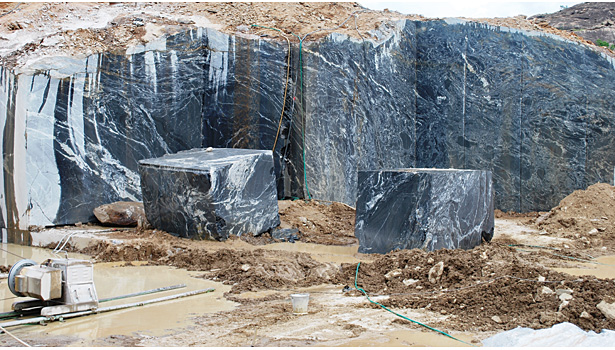Discovering Granite Quarries in South Africa Sector: From Quarry to Work of art
Wiki Article
Unearthing the Rich Background and Sustainable Practices of Granite Quarrying
As we stand on the precipice of revealing the elaborate tapestry of granite quarrying, a trip through time discloses not just the physical act of removing rock but likewise the social and historical value woven into the really fabric of this method. From the old origins that laid the foundation for modern-day quarrying techniques to the sustainable techniques that are shaping the future of this market, each carve mark on granite surfaces narrates waiting to be uncovered (granite quarries in south africa). The heritage of granite quarrying extends much past simple removal; it is a testament to human resourcefulness, strength, and the enduring allure of this stunning rockOld Origins of Granite Quarrying
Dating back to ancient people, the technique of quarrying granite has actually been an essential component of human history and building advancement. The earliest proof of granite quarrying dates back to ancient Egypt, where large pyramids and detailed sculptures were crafted from this durable stone. The Egyptians utilized primitive tools to draw out granite blocks from quarries, showcasing the value of this product in their significant building and constructions.Relocating onward in background, the Greeks additionally made significant contributions to the quarrying of granite. The Greeks used granite in various architectural marvels, such as temples and statues, demonstrating their skill in shaping and carving this sturdy stone. The Romans additionally improved the strategies of quarrying granite, using advanced tools like chisels and hammers to essence and shape granite for their famous structures.
With the centuries, the method of quarrying granite has developed, with contemporary technologies boosting effectiveness while preserving the ageless appeal of this natural rock - granite quarries in south africa. From old people to contemporary building contractors, the tradition of granite quarrying continues to shape our globe
Evolution of Quarrying Techniques
The evolution of quarrying strategies has actually been marked by a continual development towards greater performance and precision in extracting granite. From the primary techniques employed by our forefathers to the advanced modern technologies utilized in modern-day quarrying procedures, the industry has gone through significant developments. Early quarrying methods included manual work with basic devices such as chisels, hammers, and wedges to remove granite blocks from the earth. As people progressed, methods like fire-setting and primitive explosives were presented to help with the removal process.In even more recent times, the arrival of machinery changed the quarrying market, making it possible for quicker removal rates and boosted productivity. Technologies such as ruby wire saws, high-pressure water jets, and pneumatically-driven drills have come to be common in contemporary quarries, allowing for accurate cutting and lowered waste. Innovations in computer-controlled devices and 3D modeling have actually optimized quarrying operations, leading to very little ecological influence and boosted sustainability techniques. As the demand for granite continues to rise, the development of quarrying methods remains essential to meeting market needs successfully and sustainably.
Social Relevance of Granite
Granite holds an extensive cultural significance throughout numerous human beings as a result of its long-lasting existence in architectural work of arts and prized monoliths. From the majestic pyramids of Egypt to the detailed makings of the Angkor Wat temple in Cambodia, granite has been a product of selection for revealing splendour and longevity in social heritage. In old Rome, granite columns adorned temples and public structures, signifying stamina and permanence. The social relevance of granite prolongs beyond its physical attributes; it personifies durability, stability, and eternity, making it a symbol of sustaining heritages and customs.
Lasting Practices in Quarrying
Among the abundant history of granite quarrying and its cultural significance exists an expanding emphasis on lasting methods within the industry. As ecological understanding and issues about source exhaustion have enhanced worldwide, the quarrying field has actually progressively accepted sustainable techniques to lessen its effect on the atmosphere and bordering areas.
In addition, recovery and recovery of quarry websites post-extraction are indispensable to lasting techniques. By recovering quarried areas to a natural or useful state, such as creating wildlife environments or entertainment rooms, quarriers can balance out the environmental impact of their operations and add favorably to the regional environment.
Tradition of Granite Quarrying
With a historical background soaked in craftsmanship and industrial progression, what sustaining effect has granite quarrying left on the landscape of contemporary society? The heritage of granite quarrying goes beyond mere removal techniques; it has shaped building marvels, urban landscapes, and social heritage worldwide. The long lasting nature of granite has made it a preferred selection for monuments, structures, and framework, standing as a testament to the ability and creativity of quarry workers throughout generations.Additionally, the economic impact of granite quarrying can not be neglected. The sector remains to provide work chances and drive local economic situations in regions where granite removal is common. It has likewise spurred technical developments in quarrying strategies and equipment, bring about a lot more efficient and lasting practices.
In regards to sustainability, the tradition of granite quarrying consists of efforts to minimize environmental influences with reclamation jobs and responsible resource monitoring. By stabilizing economic rate of interests with ecological stewardship, the industry aims to make certain that future generations can remain to Bonuses gain from this enduring all-natural resource.
Final Thought

Report this wiki page